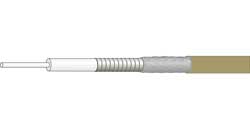In 1983, the SUCOFLEX 100 microwave cable family from HUBER+SUHNER impacted greatly on the market and to this day continues to hold its own as a leading product family. Its extensive product range and electrical and mechanical characteristics, allied to high reliability, has enabled the family to be widely used worldwide. The new SUCOFLEX 400 cable family has been designed with new features that will enable it to continue the tradition and set new standards for microwave cable assemblies, particularly in the test and measurement, defense, instrumentation and space markets.
New Requirements
In recent years, the requirements that cable assemblies must meet have changed and become increasingly demanding. For example, vibration, shock, the need for the lowest phase change in relation to temperature, RF-leakage, moisture and chemical resistance, weight, etc., are of enormous importance in defense technology. In the test and measurement market, requirements such as Flex-Life, small phase change versus bending and torsion, and high loss stability in the case of bending and shaking are priority considerations.
To better meet specific market needs, HUBER+SUHNER initiated a major initiative with the goal of designing future products, each with a market focus—basically providing a tailor-made solution for each target group. The first result of this initiative was the development of the SUCOFLEX 300 family for aerospace applications; the SUCOFLEX 400 is the latest range to be produced.
Low Insertion Loss

Figure 1 A graphical illustration of the construction of the SUCOFLEX 400.
The SUCOFLEX 400’s construction (shown in Figure 1) is a solid silver-plated copper wire center conductor, encased by an extruded ultra low density PTFE dielectric, with a silver-plated copper tape inner shield, a silver-plated copper braid outer shield and a Fluorinated Ethylene Propylene (FEP) jacket.

Table 1 Electrical Characteristic of the SUCOFLEX 404
Of particular significance is the new, extruded ultra low density PTFE dielectric, with a dielectric constant of 1.26, giving the SUCOFLEX 400 the lowest insertion loss currently available. And, despite the proportion of air, the proven mechanical stability and reliability of the extruded dielectric has been preserved. The cable’s electrical characteristics are shown in Table 1.

Figure 2 Phase stability vs. temperature (°/GHz/m vs. °C) (b).

Table 2 Attenuation/CW Power
Another highlight of the very low dielectric constant is that the Continuous Wave (CW) power capability has been increased together with a very significant improvement in phase stability versus temperature (shown in Figures 2a and 2b). This is a great advantage in applications such as phased-array antenna systems and also helps to simplify the adjustment of radars. The attenuation/CW power is shown in Table 2.
The new family of microwave cables has been specifically developed for applications on the ground for defense technology, medical and space measurement technology applications, where the lowest loss, highest performance, best phase stability versus temperature and phase stability versus bending, good return loss and mechanical stability are of the utmost importance.
Diverse Applications
The new microwave cable assembly is suitable for different applications. In defense technology, its primary use is in tactical and strategic communications and in electronic warfare (radar systems, etc.). In particular, phase-matched cable assemblies are required for radar applications. Complete sets of phase-matched, time-delay-matched or amplitude-matched SUCOFLEX 400 cable assemblies are available.
The special characteristics of the new cable assembly family are also likely to make it the preferred solution for thermal vacuum tests for satellite components or for entire satellites, as well as for applications in medical systems such as high frequency ablations of cancerous ulcers or connections between high frequency generators and probes.
The cable assemblies have been tested in accordance with the relevant MIL specifications and standards and, as a result, are suitable for numerous applications in defense technology. The products will also be subjected to a special TVAC test program for thermal vacuum applications.
Product Launch
There will be a steady roll-out of SUCOFLEX 400 products for specific relevant markets starting with the SUCOFLEX 404 (diameter 5.5 mm) with a straight male SMA connector, which will be available this month (October 2008). The SUCOFLEX 406 (diameter 7.9 mm) including N and TNC straight male connectors will follow at the beginning of 2009. This cable will have the lowest loss of the family and thus be the lowest loss product up to 18 GHz on the market. During the course of 2009, the connector range will be expanded and followed by additional thinner versions with the lowest losses for frequencies up to 40 GHz, as well as additional jackets and armor for all kinds of applications.
Conclusion
The SUCOFLEX 400 family of microwave cable assemblies is identical in design with the familiar SUCOFLEX 100 products, which have proven their reliability and stability for a wide range of applications for more than 20 years. The latest innovation though, is the new ultra low density PTFE dielectric, which has been completely redesigned and, as a result, has improved the electrical performance of the new cable. The connectors, likewise developed by HUBER+SUHNER, have been adjusted to the cable in order to preserve the excellent return loss (VSWR) on the assembly.
Current HF systems for defense, medical and space applications must comply with the highest demands, so it is essential that the accompanying connection components meet the highest standards too. The new SUCOFLEX 400 family meets these demands.
HUBER+SUHNER AG,
Herisau, Switzerland,
+41 71 353 41 11,
www.hubersuhner.com.
RS No. 301
